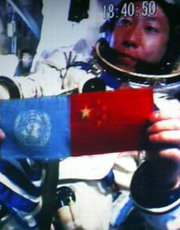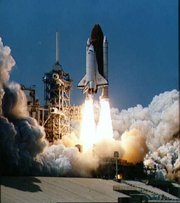Space exploration
|
|
Space exploration is the physical exploration of outer-Earth objects and generally anything that involves the technologies, science, and politics regarding space endeavors. One of the most famous and important aspects of space exploration was the landing of the first man on the moon in the space race between the United States and the Soviet Union.
From fiction to fact
The idea of sending an object to space was conceived in the minds of many science fiction authors hundreds of years before it was actually feasible. Some of these works even included various descriptions of exactly how that would be done. During the 20th century, with the development of adequate propulsion technologies, stronger and lighter materials and other technological and scientific breakthroughs, the idea of outer-earth missions was no longer a dream, but a viable practice.
The National Air and Space Museum (NASM) on the National Mall in Washington, D.C. displays a moon rock sample which the public can see and touch, a Gemini space capsule and Soviet rockets. The NASM annex at Dulles International Airport in Northern Virginia displays an unparalleled array of aerospace technology in one place: Space Shuttle Enterprise, a Concorde and scores of aircraft. The U.S. Space & Rocket Center museum in Huntsville, Alabama next to Redstone Arsenal displays many articles of space hardware, including a full-size replica of the Apollo 11 Saturn V rocket, the original Apollo and Mercury space capsule trainers, and the original Apollo 16 space capsule.
See also: The Blue Marble, a 1972 image taken during the Apollo program
Orbiting and reaching space
From a spaceflight perspective, the definition of space usually used is that space begins 100 km (62 miles) above Earth's surface. The United States sometimes uses a 50 mile definition. (See boundary to space.)
Achieving orbit is a prerequisite for going anywhere else, such as to the Moon or Mars. The first successful orbital launch was of the Soviet unmanned Sputnik I mission on October 4, 1957. This spectacular success led to an escalation of the American space program, and to an undeclared Space Race between the two superpowers. Soviet dog Laika became the first animal in orbit on November 3, 1957. The first orbital flight made by a human being was Vostok 1, carrying Yuri Gagarin on April 12 1961.
One can distinguish the sub-orbital spaceflight and the orbital spaceflight (cf. Difference between sub-orbital and orbital spaceflights). As for sub-orbital flights, on October 3, 1942 an A4 rocket, a prototype for the German V2 rocket bomb, became the first successful launch of an object into space. The first organisms launched into space were fruit flies and corn seeds aboard a U.S.-launched V2 rocket in July, 1946. Another milestone was achieved on May 17, 2004 when Civilian Space eXploration Team launched the GoFast Rocket on a suborbital flight, the first amateur space flight. On June 21, 2004, SpaceShipOne became the first privately-funded manned spacecraft.
Space agencies
Brazilian Space Agency
The Brazilian Space Agency, founded in 1994, directs one of the youngest space programs. Brazil's space program is the most advanced in South America. It suffered a major setback in 2003 due to a rocket explosion that killed several technicians. They had their first success on October 23, 2004 with a VSV-30, or Brazilian Exploration Vehicle, launched on a sub-orbital mission. The agency's primary launch site is at Alc⮴ara.
Canadian Space Agency
The Canadian Space Agency (CSA or, in French, the ASC) is the government department responsible for Canada's space programme.
It was established in March 1989 by the Canadian Space Agency Act and sanctioned in December 1990. The agency is led by its president, who reports to the Minister of Industry.
China National Space Administration
The China National Space Administration is the civilian agency in the People's Republic of China that is responsible for national space policy. The agency was created in 1993 when the Ministry of Aerospace Industry was split in two, with the other part being the China Aerospace Corp. China became only the third country on Earth to send a human into space independently on October 15, 2003 when Yang Liwei piloted the Shenzhou V mission, accomplishing 14 orbits before returning to Earth the next day.
European Space Agency
The European Space Research Organisation, also known as ESRO, was established on March 20, 1964, per an agreement signed on June 14, 1962. Although it was officially an inter-governmental space organization during the space race era, its achievements were greatly overshadowed by the U.S.-USSR rivalry.
It was succeeded by the European Space Research and Technology Centre, or ESTEC, based in Noordwijk, the Netherlands. The center is still a part of the European Space Agency, which has grown to be a much bigger organisation today.
The European Space Agency in its current form was founded in 1974, when the European Space Research Organisation merged with the European Launcher Development Organisation, or ELDO.
Indian Space Research Organisation
The Indian Space Research Organization, also known as ISRO, was established on August 15, 1969 under the Department of Atomic Energy of the Government of India. It manages all of India's space activities, and has a well developed space programme.
ISRO has capability to build and launch satellites up to 2000 kg into polar and geostationary orbit. It has 2 major satellite launch vehicles called PSLV (Polar satellite launch vehicle) and GSLV (Geostationary satellite Launch Vehicle). Most of ISRO's programs are geared towards nation building, though there are a few efforts in scientific research and space exploration. ISRO has started the work on its first Unmanned Lunar program called Chandrayan-1 (Moon-Ship-1) which is slated to be launched by 2007.
Japan Aerospace Exploration Agency
The Japan Aerospace eXploration Agency, or JAXA, is Japan's aerospace agency. It was formed October 1, 2003, by the merger of NASDA, the National Aerospace Laboratory of Japan and the Institute of Space and Aeronautical Science.
National Aeronautics and Space Administration (United States)
On July 29, 1958, President Eisenhower signed the National Aeronautics and Space Act of 1958 establishing the National Aeronautics and Space Administration (NASA). When it began operations on October 1, 1958, NASA consisted mainly of the four laboratories and some 8,000 employees of the government's 46-year-old research agency for aeronautics, the National Advisory Committee for Aeronautics (NACA).
Russian Aviation and Space Agency
The Russian Aviation and Space Agency (RKA) (in Russian: Российское авиационно-космическое агентство) is the government agency responsible for Russia's space science program and general aerospace research. It was formed after the breakup of the Soviet Union and the dissolution of the Soviet space program.
National Space Agency of Ukraine
The National Space Agency of Ukraine (NSAU) is the Ukrainian government agency responsible for space policy and programs, established in 1992. It oversees Ukraine's national and commercial space research, construction, and launch programs. Launches are conducted in Kazakhstan, Russia, and on the Sea Launch platform.
Criticisms
Space exploration has come under criticism from people. One of the most common charges is that it uses up billions of dollars of money, which could have been spent on domestic purposes. The contention is quite sharp with some stating that the money could have been used to aid the Third World countries and the betterment of the impoverished instead of being wasted on spacecraft that sometimes don't work. Some examples include the Mars Polar Lander and the Mars Observer launched in 1999 and 1993 respectively which cost millions of dollars of taxpayers' money to construct.
Timeline of Space Exploration
1957-1975
| Date | First Success | Country | Mission Name |
|---|---|---|---|
| 1946 | Animal in space (fruit flies) |  USA-ABMA USA-ABMA
| V2 |
| August 21 1957 | ICBM | Missing image Flag_of_the_Soviet_Union.png USSR | R-7/SS-6 Sapwood |
| October 4 1957 | Artificial satellite | Missing image Flag_of_the_Soviet_Union.png USSR | Sputnik 1 |
| November 3 1957 | Animal in orbit (dog) | Missing image Flag_of_the_Soviet_Union.png USSR | Sputnik 2 |
| January 31 1958 | Detection of Van Allen belts |  USA-ABMA USA-ABMA
| Explorer I |
| December 18 1958 | Communications satellite |  USA-ABMA USA-ABMA
| Project SCORE |
| September 14 1959 | Probe to Moon | Missing image Flag_of_the_Soviet_Union.png USSR | Luna 2 |
| February 17 1959 | Weather satellite |  USA-NASA (NRL)1 USA-NASA (NRL)1
| Vanguard 2 |
| August 7 1959 | Photo of Earth from space |  USA-NASA USA-NASA
| Explorer 6 |
| August 18 1960 | Reconnaissance satellite |  USA-Air Force USA-Air Force
| KH-1 9009 |
| April 12 1961 | Human in orbit | Missing image Flag_of_the_Soviet_Union.png USSR | Vostok 1 |
| March 18 1965 | Extra-vehicular activity | Missing image Flag_of_the_Soviet_Union.png USSR | Voskhod 2 |
| December 15 1965 | Orbital rendezvous2 |  USA-NASA USA-NASA
| Gemini 6A/Gemini 7 |
| March 1 1966 | Probe to another planet | Missing image Flag_of_the_Soviet_Union.png USSR | Venera 3 |
| July 21 1969 | Human on the Moon |  USA-NASA USA-NASA
| Apollo 11 |
| April 23 1971 | Space station | Missing image Flag_of_the_Soviet_Union.png USSR | Salyut 1 |
| July 15 1975 | First U.S.-USSR joint mission | Missing image Flag_of_the_Soviet_Union.png USSR  USA-NASA USA-NASA
| Apollo-Soyuz Test Project |
1Project Vanguard was transferred from the NRL to NASA immediately before launch.
2 The Soviet Union had attempted an earlier rendezvous on August 12, 1962; However, Vostok 3 and Vostok 4 were only within five kilometers of one another, and were in different orbital planes. Pravda, however, did not mention this information and indicated that rendezvous had been accomplished.
post-1975
| Date | First Success | Country | Mission Name |
|---|---|---|---|
| April 12 1981 | Reusable manned spacecraft |  USA-NASA USA-NASA
| STS-1 |
| June 13 1983 | Extra-solar system spacecraft |  USA-NASA USA-NASA
| Pioneer 10 |
| September 11 1985 | Comet probe |  USA-NASA USA-NASA
| International Cometary Explorer |
| April 28 2001 | Space tourist |  Russia Russia  USA USA
| Soyuz TM-32 |
| June 21 2004 | Privately developed manned spacecraft |  USA-MAV USA-MAV
| SpaceShipOne 15P |
Reusable spacecraft
The first reusable spacecraft (space shuttle) was launched by the USA on the 20th anniversary of Gagarin's flight, April 12 1981. The first (and so far only) automatic reusable spacecraft was Buran, launched by the USSR on November 15 1988.
See also
Unmanned missions
Main article: Unmanned space missions
- Pioneer program
- Luna program
- Zond program
- Venera program
- Mars probe program
- Ranger program
- Mariner program
- Surveyor program
- Viking program
- Voyager program
- Vega program
- Phobos program
- Discovery program
Animals in space
Humans in space
Main articles: Astronauts and human spaceflight
- List of human spaceflights
- List of human spaceflights chronologically
- List of human spaceflights by program
- Vostok program
- Mercury program
- Voskhod program
- Gemini program
- Soyuz program
- Apollo program
- Salyut program
- Skylab
- Space Shuttle program
- Mir
- International Space Station
- Shenzhou spacecraft
- Crew Exploration Vehicle
- Vision for Space Exploration
- Aurora Programme
- Tier One
- Human adaptation to space
Recent and future developments
- Exploration of Mars
- Future energy development
- Space tourism
- Private spaceflight
- Space colonization
- Interstellar spaceflight
Other
External link
- http://space.skyrocket.de/
- http://www.planet4589.org/space/
- http://www.nasa.gov
- http://www.vastbeyond.com
- http://www.space.com
- http://www.spacelist.org
- http://www.space-exploration.org
- http://www.universetoday.com
- National Space Society (http://www.nss.org/) - non-profit organization that promotes a spacefaring civilization


